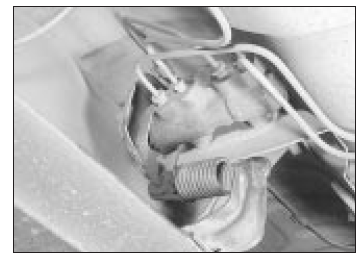Opel Corsa B 1993–2000 Service and Repair Manual: Pressure regulating valves - testing, removal and refitting
Testing
1. Accurate testing of either type of pressure regulating valve (master cylinder mounted or underbody mounted) is not possible without special equipment. Malfunction may be suspected if the rear brakes lock prematurely in heavy braking, or if they seem not to be functioning at all.
2. A quick check of the underbody mounted valve fitted to Estate and Van models may be made by observing the valve whilst an assistant makes sharp applications of the brake pedal. (The weight of the vehicle must be on its wheels.) The lever on the valve must be seen to move as the pedal is depressed and released; if not, the valve is certainly defective.
Removal
Hatchback and Saloon models
Note: Renew both valves as a matched pair to ensure that the braking is not adversely effected.
3. Empty the master cylinder reservoir.
4. Wipe clean the area around the valves and place absorbent rags beneath the pipe unions to catch any surplus fluid. Make a note of the correct fitted positions of the unions then unscrew the union nuts and carefully withdraw the pipes. Plug or tape over the pipe ends and master cylinder orifices to minimise the loss of brake fluid and to prevent the entry of dirt into the system. Wash off any spilt fluid immediately with cold water.
5. Unscrew the valves from the master cylinder.
Estate and Van
6. Minimise fluid loss by first removing the master cylinder reservoir cap, and tightening it down onto a piece of polythene to obtain an airtight seal.
7. Raise and securely support the rear of the vehicle.
8. Slacken the valve spring bracket, push the bracket rearwards and unhook the spring from it (see illustration).

Load-dependent pressure regulating
valve, spring and bracket - Estate and Van
models
9. Clean around the hydraulic unions. Identify the unions with tape or dabs of paint, then unscrew them from the valve. Be prepared for fluid spillage.
10. Unbolt and remove the valve.
Refitting
Hatchback and Saloon models
11. Make sure that both new valves are of the same type and are stamped with the same numbers (indicating their calibration). The valves must always be renewed in pairs, even if only one seems to be defective.
12. Fit the valves to the master cylinder and tighten them to the specified torque.
13. Reconnect the brake pipes, tightening the union nuts to the specified torque.
14. Bleed the complete hydraulic system.
Estate and Van
15. Transfer the stone guard to the new valve.
16. Bolt the new valve to the underbody and tighten the mounting bolts to the specified torque.
17. Connect the brake pipes, tightening the union nuts to the specified torque.
18. Bleed the complete hydraulic system.
19. Attach the spring to the valve and to the spring bracket. Adjust the position of the spring bracket so that the spring is neither taut nor slack, then secure the bracket.
20. Lower the vehicle. Perform a road test to confirm that rear brake operation is satisfactory. Note that increasing the spring tension increases the pressure to the rear brakes, and vice versa.
 Master cylinder - removal and
refitting
Master cylinder - removal and
refitting
Note: Before starting work, refer to the
warning at the beginning of Section 2
concerning the dangers of hydraulic fluid.
Removal
1. Remove the master cylinder reservoir cap
and syphon the hydrau ...
 Brake servo vacuum hose and
non-return valve - renewal
Brake servo vacuum hose and
non-return valve - renewal
1. The plastic hose fitted as original
equipment cannot be re-used; to renew the
valve, the hose must therefore be renewed as
well. A serviceable valve can, however, be
transferred to the new hose ...
See also:
Opel Corsa B 1993–2000 Service and Repair Manual. Contact breaker points -
removal and refitting
1. When significant pitting or burning of the
contact faces has occurred, the contact set
should be renewed. It is not an expensive item
and is worth renewing as a preventive
measure at alternate ...
